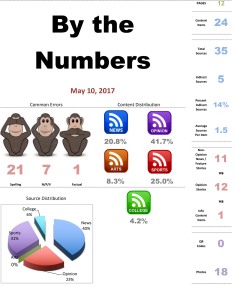 As I look at the challenges my journalism educator colleagues face these days and having to deal with remote teaching I mostly am glad that I retired from full-time teaching a few years ago, but there are times when I wish I was back in the game.
As I look at the challenges my journalism educator colleagues face these days and having to deal with remote teaching I mostly am glad that I retired from full-time teaching a few years ago, but there are times when I wish I was back in the game.
I still pick up part-time teaching gigs, and I have nearly 15 years of experience teaching online, so I am sure I could adapt to remote teaching, though it has some different challenges than online instruction: for one thing, I’ve long held that online courses are not for every student or for every teacher and now everyone is having to adapt ready or not. And while the spring semester could be chalked up to an aberration, an accident of time, it does not look like returning to the classroom will be the norm for at least another year.
I’ve often been an early adopter of technology, but one aspect of teaching journalism and advising student publications always eluded me: the clubhouse effect of the student newspaper classroom. It is a powerful tool for teaching journalism and engaging students and now it has been ripped away for the time being. As I was teaching online classes I often pondered on how to transform the camaraderie of staff meetings and late production nights with a solid, tangible product of a newspaper (or magazine or yearbook) at the end. With no one on campus to pick up a printed paper why print one?
Oh, sure, fewer and fewer people on campus were picking them up any way, and online/mobile/social media sites have been scratching at the door for years industry wide, but there was still some powerful magic in the student newsroom and the final product. Over the years so many students found their calling in life “working in the clubhouse.” Today, the clubhouse is virtual and scattered and my colleagues are working like mad to recreate the magic.
And it is not just the newspaper that is affected by this new trend. I remember consoling my radio-tv teaching colleague years ago as he saw his student radio station being forced to give up its clubhouse. He, too, hung on to his college days of working all night alone at his college radio station and learning so much. He more or less gave up and waited out time until he was eligible for retirement.
A part of me is glad that I don’t have to figure it out these days. Leave it to younger, sharper minds. But there is an inner voice in me whispering, “Wouldn’t it be cool to transform that clubhouse; today you’d HAVE to do it. Stop thinking and start doing.”
Another thing that dogged me for so many years was how to get students to stop setting all story deadlines to the day before the print edition came out. I used to say often that “might students put out a daily newspaper once a week.” We had a strong online site and even that was years behind. Students had a hard time embracing it as the primary deadline driver..
The print edition, while exciting to put together, was anachronistic. I still like reading newspapers in the old page layout format, but I rarely pick up a print version any more. I am a digital edition subscriber to most publications, and even read their online editions more than before.
And funding the print edition was getting more and more difficult as advertising dried up and fewer people were picking it up. COVID-19 and remote teaching just might force students to do what the industry has been facing for years and put more attention to a daily. Some programs have gone to putting out fewer and fewer print publications: imagine what that means when you still use the print deadline as the deadline driver!
What got me thinking of this today especially was an article I read online about the New York Daily News announcing the shutdown of its newsroom and the writer’s lament. After the pandemic is over, the newsroom/clubhouse will not come back. Technology has rendered it anachronistic.
Journalism education, especially at the community college level, needs to work harder at preparing tomorrow’s workforce for tomorrow, not for yesterday. If I were still advising student publications that would make me sad, but the challenge would excite me.





